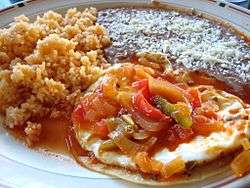Sincronizada
|
A sincronizada made with ham, oaxaca cheese and topped with salsa and pico de gallo | |
| Course | Lunch, snack |
|---|---|
| Place of origin | Mexico |
| Serving temperature | Warm |
| Main ingredients | Ham, cheese, tortillas |
|
| |
In traditional Mexican cuisine, the quesadilla sincronizada (Spanish pronunciation: [kesaˈðiʝa siŋkɾoniˈsaða], "synchronized quesadilla") is a tortilla-based sandwich[1] made by placing ham[2] and sometimes refried beans and chorizo and a portion of Oaxaca cheese (or any type of cheese) between two flour tortillas.[3] They are then grilled or even lightly fried until the cheese melts and the tortillas become crispy, cut into halves or wedges and served, usually with salsa and pico de gallo, avocado or guacamole on top and/or other toppings or condiments.
In some American Tex-Mex eateries, such as Taco Bell, some quesadillas and/or sincronizadas may include chicken fajita meat. Fajita meat is not traditionally used in Mexico, as fajitas is a Tex-Mex dish, and not a Mexican one. In fact, the name "fajitas" is virtually unknown in Southern Mexico as a dish, although there are somewhat similar alambre dishes enjoyed throughout Mexico.
They are frequently confused with plain quesadillas, due to their resemblance to "quesadillas" sold in Mexico and the United States.[4] (U.S. quesadillas are usually made with flour tortillas rather than molded from masa in the Mexican style). Note however, despite the fact it looks almost the same as a quesadilla, it is considered as a completely different dish. The main difference between the real quesadilla and the sincronizadas is the obligatory inclusion of ham in the dish and the main ingredient used to make the tortilla (wheat flour instead of corn flour, masa harina).[5] A quesadilla is made of a single folded and filled corn tortilla, while the sincronizada is prepared like a sandwich.
Ingredients could vary between Oaxaca cheese, Manchego cheese and different types of ham. The sincronizada is sometimes consumed alone, but in most regions of Mexico it is common to add a regional sour cream, salsa or guacamole as topping to make a richer flavor. The Tex-Mex version also contains beans, cheese, beef fajita meat and avocado and Monterey Jack cheese instead of the traditional Oaxacan one.
Sincronizadas are commonly consumed in the evening, as a component of a light Merienda. Despite being labeled fast food, they are eaten by many who wish to enjoy a small meal.[6]
A similar dish is the gringa, which is prepared in exactly the same way as a sincronizada, but using carne al pastor instead of ham. Despite its similarities, it is considered as a completely different dish. The gringa is also extremely greasy, since the carne al pastor used for its preparation is usually made of cooked pork meat often reheated on an oily comal before being placed between the tortillas (corn flour) and the cheese also contains a lot of oil.
See also
References
- ↑ Maria Elena Cuervo-Lorens, (1989) «Maria Elena's Mexican Cuisine: Authentic Mexican Dishes Made Easy», pp:146
- ↑ http://www.mexican-authentic-recipes.com/antojitos-sincronizada.html
- ↑ "The Sincronizadas". Mexican-authentic-recipes.com. Retrieved 7 July 2015.
- ↑ Raichlen, Steven (1998). Salud y sazón: 200 deliciosas recetas de la cocina de mamá : todas bajas en grasa, sal y colesterol! (in Spanish). Rodale. p. 246. ISBN 978-0-87596-474-4. Retrieved 2011-03-11.
- ↑ Luis Peinado, Marilyn Peinado (1992), «Bienvenidos to our kitchen: authentic Mexican cooking», Pelican Publishing Company, pp:66
- ↑ Albala, Ken (2011). Food cultures of the world encyclopedia (Vol. 2 ed.). Santa Barbara, Calif.: Greenwood. p. 222. ISBN 9780313376276.
External links
 The dictionary definition of sincronizada at Wiktionary
The dictionary definition of sincronizada at Wiktionary

